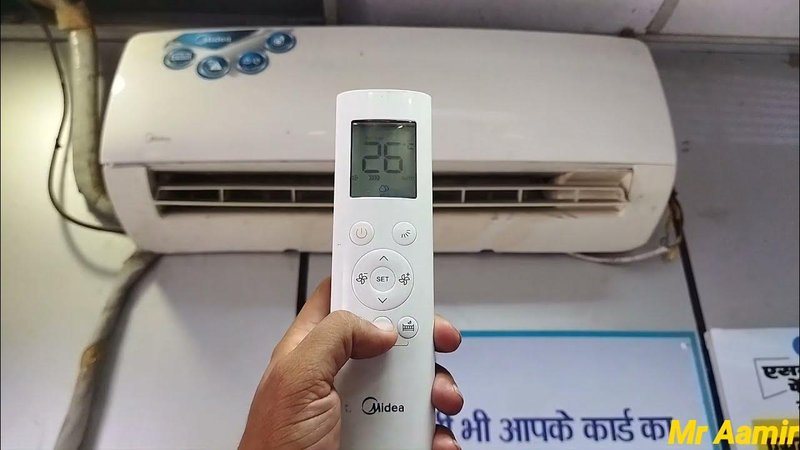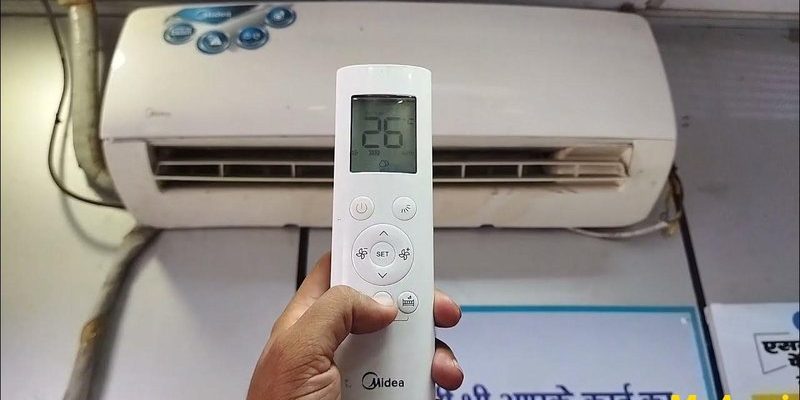
Let me explain it another way. Your Midea AC remote works by sending out an **infrared (IR)** signal—a beam of invisible light that carries instructions straight to your air conditioner. It’s kind of like flashlight Morse code, but way less dramatic. When this “code” gets scrambled or blocked, that’s when signal interference rears its ugly head. If you’ve ever jiggled the remote, swapped out batteries (again), or even smacked it on your palm hoping for a miracle, you’re definitely not alone.
The Basics of How a Midea AC Remote Works
First things first—what’s going on inside that little plastic stick? The **Midea AC remote** is basically a messenger, using its IR sensor to beam tiny bursts of light (not visible to the human eye) carrying coded information. When you hit “cool,” “fan,” or “power,” the remote translates your command into a specific pulse pattern, which is understood by your air conditioner’s receiver.
This whole process relies on a clear, direct path. Imagine trying to shine a laser pointer through a bunch of stacked books—that’s what happens when something gets between your remote and the AC. The signal weakens or gets completely blocked. And because these signals aren’t magic (though I wish they were), literally anything in the way—a plant, chair, or even sunlight—can muddle things up.
What’s even wilder? IR signals can’t go through solid objects. So, unlike your TV remote that might still work bouncing off a wall, your Midea remote gets grumpy if anything breaks its line of sight. That’s why you’ll notice it working great up close, but suddenly turning stubborn when you try from behind the couch.
Common Physical Obstructions and Barriers
Let’s talk about the regular culprits first—just plain, physical stuff. Your Midea AC remote depends on a crystal-clear line between itself and the AC unit. If there’s something in the way—even something you hardly notice—your remote’s going to have a tough time.
- Furniture: Anything big (like a sofa, shelf, or curtain) between you and the AC? IR signals just bounce off or get absorbed. You might as well be yelling to a friend from another room with the door shut.
- Decorative Items: Sometimes, even a vase, plant, or picture frame on a table can interrupt the signal. IR signals are not powerful enough to sneak around those obstacles.
- Dirty or Fogged Sensors: The little “eye” on your remote or on the AC unit itself needs to be clear. Dust, grime, or even condensation can block or scatter the beam.
Here’s the thing: we don’t always realize these small things make such a big difference. I once wasted a whole afternoon swapping batteries on my remote, only to realize a stack of magazines was blocking the sensor on my wall-mounted AC. Lesson learned.
Other Electronic Devices That Cause Interference
You might be wondering, “Can other gadgets in my room get in the way?” The answer: yes—and they might even be sneakier than physical obstacles. There are actually a bunch of electronic devices that can interfere with your remote’s signal, either by emitting IR light themselves or by producing electromagnetic “noise.”
- Fluorescent Lights: Some types of lighting, particularly older or flickering bulbs, can create IR interference, leaving your remote’s signal totally scrambled.
- TV Remotes and Other IR Devices: Got a universal remote? Or multiple IR devices in one room? They sometimes “talk over” each other by sending overlapping codes, confusing your AC into thinking it just got a dozen different commands at once.
- WiFi Routers and Wireless Devices: While WiFi is on a different wavelength, too many wireless signals in a small space can sometimes add to overall **electromagnetic interference** (EMI) that mucks up how clearly your AC receives remote commands—especially in small apartments with tons of gadgets.
Honestly, if you live in a “smart home” paradise—or, like me, just have too many remotes lying around—you might accidentally cause your Midea remote to stop working just by being a little too tech-savvy.
Sunlight and Ambient Light Sources
At first glance, you’d never guess that a sunny room could be a problem for your remote. After all, natural light is supposed to be a good thing, right? But the truth is, the sun is a total showoff when it comes to IR. If you’ve got a big window beaming sunlight right onto your AC’s sensor, the little IR signal from your Midea remote doesn’t stand a chance.
Let me paint the picture: it’s like trying to have a quiet conversation in the middle of a rock concert. The sun floods the space with IR radiation so strong, your remote’s feeble little pulses get completely drowned out. Even some powerful LED bulbs can add “noise” that interferes with your remote’s ability to pair or sync with the AC.
If your signal feels weakest in the brightest part of the day, or you have to stand directly in front of the unit when the sun’s out, ambient light interference could be the sneaky villain. Try closing the curtains partially or repositioning your AC (if possible) away from direct sunlight. Tiny change, big difference.
Battery Issues: The Silent Saboteur
I know, I know—everyone thinks of dead batteries right away. But it’s not always that simple. **Weak or dying batteries** can cause all sorts of problems that feel like “signal interference,” when in fact the remote just isn’t juicing enough power to send a proper IR blast.
Here’s the classic scenario: you hit the button, and nothing. Or maybe it works if you stand right in front of the AC, but not further away. That’s usually the first sign your batteries are on their last legs. Sometimes, even brand-new batteries can cause trouble if they’re mismatched or not inserted properly. If you’ve ever accidentally put one in backward (guilty), you know what I mean.
Pro tip? Always swap both batteries at the same time, make sure they’re fresh from the same pack, and double-check the positive/negative symbols. It’s also worth cleaning the battery contacts with a cotton swab—corrosion can sneak in over time and kill your connection, making it look like a mysterious signal issue when it’s really just a little rust.
Problems With Remote or AC Sensor Hardware
Sometimes, the issue isn’t outside interference at all—it’s a problem *inside* the remote or the AC itself. The IR emitter on your Midea AC remote can wear out over time, especially if it’s taken a tumble (or three) onto a hard floor. If the sensor on the AC unit gets knocked around or damaged, it might not “see” the remote at all.
You might notice this if:
- Other remotes work fine in the same room, but not your AC remote.
- Your remote works perfectly on another Midea AC (like at a friend’s place), but not on your own unit.
- The remote only works at odd angles or super close-up, suggesting the IR beam isn’t focusing properly.
At that point, it’s time to consider a little troubleshooting:
- Reset the remote and AC (unplug the unit for 30 seconds, remove batteries, and try again).
- Check for firmware updates or codes if you’re using a universal remote.
- If you’re comfortable, inspect the IR emitter inside the remote (you can sometimes spot if the bulb is loose or cracked).
If all else fails, it might be a hardware repair or replacement situation—but at least you’ll know what you’re dealing with!
Code, Pairing, and Sync Errors
You might be thinking, “Wait, isn’t it just point and click?” Not always. If you’re using a **universal remote** or a replacement that’s supposed to work for your Midea air conditioner, but suddenly nothing’s happening, there may be issues with how it’s coded, paired, or synced.
Universal remotes need to be programmed with the right code to “speak” Midea’s unique IR language. If that code is mistyped, or if it somehow resets (like after a battery change), your remote could send out a completely different set of signals. That’s like trying to order coffee in perfect French at a café in Tokyo—just not gonna work.
The trick here is patience. Double-check your remote’s manual, make sure you enter the pairing code exactly (no shortcuts!), and perform any required reset steps. Sometimes, just re-pairing or resyncing the remote after a battery swap can fix everything.
And yes, if you ever rent a place and find a universal remote taped to the wall with “works for AC” scribbled on the back, be prepared to do a little code wrangling before it’ll obey your commands.
Comparing Midea Remotes With Universals: Is There a Difference?
Honestly, there’s a bit of a trade-off here. **Midea’s original remotes** are fine-tuned for their own AC units, which means fewer code or sync headaches. They’re less likely to run into signal mismatches, as their “language” is a perfect match for your specific air conditioner.
Universal remotes, though, are like the language whizzes of the remote world—they *can* talk to tons of devices, but sometimes get the dialect slightly wrong. They’re great as backups, but you may notice more occasional glitches, especially when it comes to catching every single button press (or transmitting custom, model-specific commands).
Also, universals sometimes emit a weaker IR beam, which compounds any interference from batteries, electronics, or sunlight. If you’re constantly battling connection issues, switching back to the original Midea remote can be a lifesaver.
Even the smallest difference in signal strength or code accuracy can make all the difference—especially as your AC unit ages or if you’ve got a busy, gadget-filled living room. When in doubt, originals tend to be less hassle in the long run.
Troubleshooting and Solutions: Getting Your Midea AC Remote Back On Track
At this point, you’re probably itching to try one of these fixes. Here’s what I usually recommend, step-by-step, for everyday signal woes:
- Clear the line of sight. Move furniture, decor, or anything that could block the remote’s path to the AC’s sensor.
- Clean both sensors. Take a soft, dry cloth and gently wipe the remote’s IR window and the AC’s receiving “eye.” No harsh cleaners, please!
- Replace batteries. Fresh pair, inserted correctly, every time.
- Avoid bright light. Shut curtains or dim overhead lights if you notice the remote only fails in certain light conditions.
- Check for other IR devices. Turn off other remotes or test your Midea AC with everything else powered down to see if another device is stealing the spotlight.
- Test the remote on another Midea AC (if possible). Or try a universal remote with your AC to see if the problem follows the remote or stays with the unit.
- Code and sync check (with universals). Re-enter the pairing code. Reset both the AC and the remote and follow the manufacturer instructions to a “T.”
Patience is key. Sometimes, what feels like a big technical failure ends up being a tiny speck of dust or a forgotten “low battery” warning.
Wrapping Up: Enjoying a Hassle-Free Midea AC Remote
Signal interference with your Midea AC remote isn’t some dark, unsolvable mystery—it’s just a combination of physical obstacles, rival electronics, sunlight, battery quirks, or the occasional code mishap. Most of these can be fixed with a little detective work and a few simple tweaks. There’s no need to toss your remote in frustration (or at the wall, please don’t!).
Once you know what to watch for—like IR-blocking objects, bright sunlight, or low batteries—you can save yourself loads of head-scratching. And if you ever have to explain it to someone else, just remember: your remote is a shy introvert that needs a clear, quiet path to do its job.
Here’s to brisk, cool air and a remote that actually listens. If only other things in life were that simple, right?
